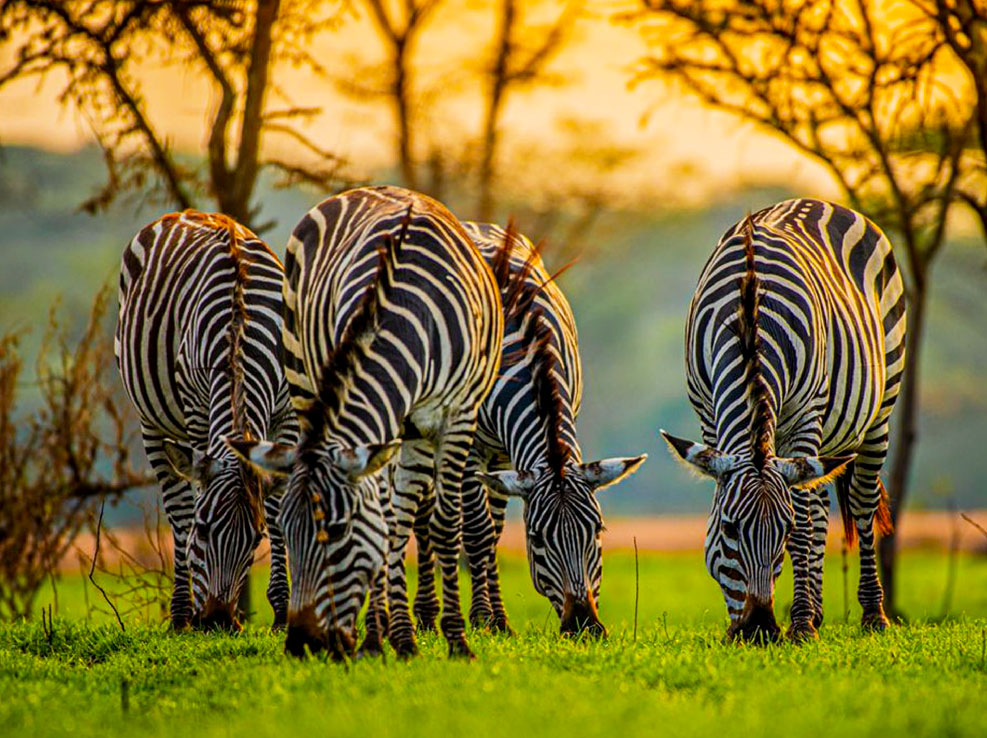Lake Mburo National Park is one of Uganda’s smaller but ecologically rich national parks, known for its diverse wildlife, beautiful landscapes, and the presence of several lakes within its boundaries. Located in the western part of Uganda, near the town of Mbarara, it is easily accessible from Kampala, making it a popular destination for short wildlife excursions.
Features and Highlights
-
Wildlife: Lake Mburo National Park is home to a variety of wildlife, including zebras, impalas, elands, topis, buffaloes, and hippos. It is also one of the few parks in Uganda where you can see Rothschild giraffes. Predators such as leopards and hyenas are present but are more elusive.
-
Bird Watching: The park is a haven for bird enthusiasts, with over 350 bird species recorded. Notable birds include the African finfoot, the papyrus yellow warbler, and the red-faced barbet. The lakes and swamps within the park attract a variety of water birds.
-
Aquatic Life: The park contains 13 lakes, with Lake Mburo being the largest. These lakes support a variety of aquatic life, including hippos and crocodiles, and are surrounded by lush papyrus swamps.
-
Scenic Landscapes: The park’s landscape is characterized by rolling hills, open savannahs, acacia woodland, rocky outcrops, and swamps. This diverse terrain supports a wide range of flora and fauna.
Getting There
-
By Road: Lake Mburo National Park is about a 4-5 hour drive from Kampala, making it one of the most accessible parks in Uganda. The main entrance is through the Sanga Gate, which is located off the main Kampala-Mbarara road. A 4×4 vehicle is recommended, especially during the rainy season.
-
By Air: There are chartered flights available from Entebbe International Airport to Mbarara Airstrip, which is about a 1-hour drive from the park. This is a quicker option for those preferring to fly.
Best Time to Visit
The best time to visit Lake Mburo National Park is during the dry seasons:
- June to August: This period offers excellent wildlife viewing as animals congregate around water sources.
- December to February: Another good time for wildlife viewing, with minimal rainfall and more predictable weather.
The wet seasons (March to May and September to November) can make some roads and trails challenging, but the park is lush and green, and there are fewer tourists.





Activities
- Game Drives: The park offers guided game drives, particularly in the early morning and late afternoon when wildlife is most active. These drives provide opportunities to see a variety of animals, including the park’s large herbivores.
- Boat Cruises: Boat trips on Lake Mburo provide close-up views of hippos, crocodiles, and water birds. The boat cruises are a relaxing way to experience the park’s aquatic life and birdlife.
- Bird Watching: With its diverse habitats, the park is a prime location for bird watching. Guided bird-watching tours are available, and the best spots include the swamps and lakeshores.
- Nature Walks: Guided nature walks offer a chance to explore the park on foot, getting closer to wildlife and experiencing the park’s diverse ecosystems. Walks can be arranged to various locations, including the salt lick area where animals gather to lick the salty soil.
- Horseback Safaris: One of the unique activities in Lake Mburo National Park is horseback riding safaris. These provide a unique way to view wildlife up close without the noise of a vehicle.
- Biking Safaris: The park offers biking trails, allowing visitors to explore the landscape and view wildlife from a bicycle. This is a great way to enjoy the park’s scenery and get some exercise.
- Fishing: Lake Mburo is popular for fishing, particularly for tilapia. Visitors can fish from designated spots along the lake.
- Cultural Encounters: The nearby communities offer cultural experiences, including traditional dances, storytelling, and visits to homesteads. This provides insights into the local Ankole culture.
Lake Mburo National Park offers a diverse range of activities and landscapes, making it a unique destination for wildlife enthusiasts, bird watchers, and those seeking a serene and scenic environment. Its accessibility from Kampala makes it a perfect choice for a short safari experience in Uganda.








